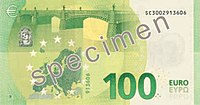
Back ورقة 100 يورو Arabic ১০০ ইউরো নোট Bengali/Bangla Bitllet de cent euros Catalan Χαρτονόμισμα 100 ευρώ Greek Billete de cien euros Spanish 100-eurone rahatäht Estonian Billet de 100 euros French Billete de 100 euros Galician Uang 100 Euro ID Banconota da 100 euro Italian
| (Eurozone (mainly) and other countries) | |
|---|---|
| Value | 100 euro |
| Width | 147 mm |
| Height | 82 (1st series) 77 (Europa series)[1] mm |
| Security features | A hologram patch with perforations, a EURion constellation, watermarks, microprinting, ultraviolet ink, raised printing, a security thread, matted surface, see-through number, colour-changing ink, barcodes and a serial number[1] |
| Material used | Cotton fibre[2] |
| Years of printing | 1999–2018 (1st series)[citation needed] Since 2018 (Europa series)[citation needed] |
| Obverse | |
 | |
| Design | Window in the baroque and rococo style.[3] |
| Designer | Robert Kalina (1st series)[4] Reinhold Gerstetter (Europa series)[5] |
| Design date | 3 December 1996 (1st series)[4] 17 September 2018 (Europa series)[6] |
| Reverse | |
 | |
| Design | Bridge in the baroque and rococo style and map of Europe.[3] |
| Designer | Robert Kalina (1st series)[4] Reinhold Gerstetter (Europa series)[5] |
| Design date | 3 December 1996 (1st series)[4] 17 September 2018 (Europa series)[6] |
The one hundred euro note (€100) is one of the higher value euro banknotes and has been used since the introduction of the euro (in its cash form) in 2002.[7] The note is used in the 25 countries (and Kosovo) that have adopted the euro as their sole currency, representing some 350 million people.[8][9] In July 2024, there was an estimated 3,987,000,000 hundred euro banknotes in circulation in the eurozone. The note is the third most widely-circulated denomination, accounting for 13.3% of the total banknotes.[10]
The design of the Europa series 100 euro banknote was revealed on 17 September 2018 and launched on 28 May 2019.[11]
- ^ a b "ECB: Security Features". European Central Bank. ecb.int. 2002. Archived from the original on 2012-08-30. Retrieved 22 October 2011.
- ^ "ECB: Feel". European Central Bank. European Central Bank. 2002. Archived from the original on 2011-10-21. Retrieved 9 October 2011.
- ^ a b "ECB: Banknotes". European Central Bank. European Central Bank. 2002. Retrieved 13 October 2011.
- ^ a b c d "Banknotes design". ECB.int. European Central Bank. February 1996. Archived from the original on 10 May 2013. Retrieved 13 October 2011.
- ^ a b "Europa series design - ECB - Our Money". www.new-euro-banknotes.eu. 2013. Retrieved 6 August 2013.
- ^ a b "ECB: Europa series". ECB. 2013. Retrieved 24 June 2013.
- ^ "Witnessing a milestone in European history". The Herald. Back Issue. 1 January 2002. Archived from the original on 1 August 2018. Retrieved 23 October 2011.
- ^ "ECB: Map of euro area". ECB. ecb.int. 1 January 2023. Retrieved 25 November 2024.
- ^ "By monetary agreement between France (acting for the EC) and Monaco". 31 May 2002. Retrieved 30 May 2010.
- "By monetary agreement between Italy (acting for the EC) and San Marino". 27 July 2001. Retrieved 30 May 2010.
- "By monetary agreement between Italy (acting for the EC) and Vatican City". 25 October 2001. Retrieved 30 May 2010.
- "By monetary agreement between European Union and the Principality of Andorra". 17 December 2011. Retrieved 25 November 2024.
- ^ "ECB Statistical Data Warehouse,Reports>ECB/Eurosystem policy>Banknotes and coins statistics>1.Euro banknotes>1.1 Quantities". ECB. European Central Bank.
- ^ "ECB unveils new €100 and €200 banknotes".